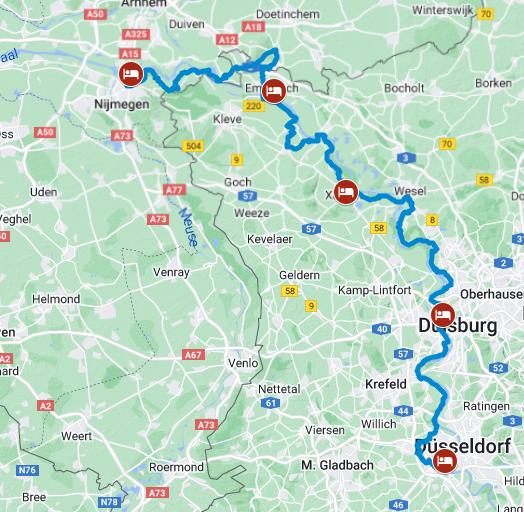

"The Hanseatic cities - then and now" is the credo of this 455-kilometre cross-border route. A fascinating cycle tour which follows the footsteps of German and Dutch merchants, full of history and modernity.
This is the 1st stage of our International Hanseatic Cities Route - 11-days tour.
On this 7-day cycle tour you will cycle part of this route, downstream along famous rivers from Neuss in Germany to Nijmegen in the Netherlands, through beautiful nature and varied landscapes. Experience the splendour of historic trading towns one after the other. Cycle through medieval alleys and old quays, past the remains of the city walls and high warehouses and discover that time has not stood still.
Attention! This is a 'app only' trip, so the route information is only available by app on your mobile phone.
| Day 1 | Arrival in Neuss (D) | |
| Arrival in Neuss. The hotel is located in a quiet spot a few kilometres outside the city centre on the banks of the Rhine. Tomorrow's cycle tour will take you through the heart of the Hanseatic city of Neuss anyway. If you are early, you can still explore Düsseldorf's old city centre and it's famous Königsallee from the hotel today. |
||
| Day 2 | Neuss (D) - Homberg (D) | |
| You soon reach the centre of Neuss is a lively, former Hanseatic city on the Rhine with old warehouses, a sizeable inner harbour and historical sights. Especially worth a visit is the imposing Quirinus-Münster, which was awarded the honorary title of 'basilica minor' by Pope Benedict XVI on the occasion of its 800th anniversary. Next to this beautiful church is the market square with several cafés and restaurants. Just past the centre of Neuss, the Hanseatic Towns Cycle Route shows its best side: for here it runs along the North Canal. Tall trees line the cycle path, cool air rises from the canal and dozens of birds chirp in the branches. The diversions via Meerbusch is very entertaining, as it takes you through Millionärsland. Meerbusch has the highest density of ultra-rich. Futuristic, all-glass villas and delightfully old-fashioned-looking cottages - it is hard to decide which one you would prefer to live in. The route briefly deviates from the Rhine to visit the centre of Uerdingen. This little town received city rights back in 1255.Then continue past Atrop to Homberg, a bit of Duisburg on the left bank of the Rhine. |
||
| Day 3 | Homberg (D) - Xanten (D) | |
| From the hotel it is only a stone's throw to the Friedrich Ebert Bridge - the Hansa Cycle Route continues over it to Wesel. Behind Duisburg, everything is a bit bigger: mighty container ships sail on the Rhine and the Hansa Cycle Route temporarily becomes a cycling motorway. On flat gravel and with a slight tailwind, the cycle kilometres flow along far faster than the Rhine. But as always, the landscape soon changes again and it becomes idyllic: free-range sheep populate the dikes, bleating and watching the cyclists. Shortly before Wesel, the renaturalised mouth of the Lippe awaits the cyclists. From the mouth of the Lippe, the Hanser cycle path leads directly into the city centre. Wesel suffered a very similar fate to Neuss during the Second World War. Architectural beauty fell victim to the bombs and what was hastily raised in the post-war years was primarily functional. But still: some particularly beautiful buildings have survived the test of time and others have been faithfully rebuilt. After Wesel, you cross the Rhine again over a bridge to the left side of the Rhine. There you cycle through the nature reserve 'Bislicher Insel' |
||
| Day 4 | Xanten (D) - Emmerich (D) | |
| On the way down, you cycle through the historic centre of Xanten once again. And if you didn't manage to visit the archaeological park with the excavations of the ancient Roman town yesterday, you will now get another opportunity. The route continues past 2 lakes that invite you to swim and go boating. Follow the Rhine downstream through the Reeser Schanz nature reserve and take the passenger ferry 'Rääße Pöntje' to historic Rees, the oldest town on the Lower Rhine. Most of the medieval town walls have been preserved to this day, along with the round tower, the mill and customs tower and several watchtowers. Here you will also find one of the most beautiful German Rhine promenades, an excellent place for a well-deserved coffee break. Over the bridge at Rees you cross the Rhine again and pass inviting bathing lakes on the way to Kalkar & Grieth. In Kalkar, enjoy the medieval architecture, the houses with stepped gables around the market square, the beautiful town hall and the old court lime tree. After Grieth, you pass Germany's longest suspension bridge, the 'Golden Gate of the Lower Rhine', on your way to Emmerich. In the old Hanseatic city you can stroll along the beautiful Rhine promenade this evening. |
||
| Day 5 | Emmerich (D) - Nijmegen (NL) | |
After leaving Emmerich, you will soon pass the German-Dutch border and go up and down through the hilly Montferland. In 's Heerenberg, a lively terrace village with historic alleys, you will find one of the largest medieval castles in the Netherlands, Kasteel Huis Bergh. Cycle through the green Bergherbos and then descend again after the German town of Elten to the Gelderse Poort, the special place where the Rhine has broken through the moraine. Through the watery Ossenwaard and the new, bird-rich nature of Carvium Novum you finally reach the Waal.
|
||
| Day 6 | Return home | |
| Today you will end your cycling trip after breakfast. |
||
Starting dates:
Every Saturdays and Sundays from May till September
The hotels or B&Bs on this trip have been carefully selected for their location, atmosphere and/or unique services. All rooms are en-suite. A list of the hotels we work with appears below. If a certain accommodation is unable to confirm due to lack of availability, we will request a comparable alternative.
When selecting the accomodation, we try to take into account as much as possible a safe and closed bicycle shed. However, we cannot do this with all of them guarantee and this partly depends on the number of bicycles of other guests.

5 Nights included

3/4 Star Hotels

Breakfast included

The possibility of renting our bikes

7-days week service hotline

Luggage transport to your next hotel


Parking possibilities at the hotel

For this trip, route information is only available through our navigation app. You will not receive any travel information or route information on paper.

Any ferry crossings are not included

The nearest airport is Düsseldorf Airport (DUS) or Amsterdam Airport Schiphol (AMS).

Neuss and Nijmegen - Lent have their own train station.
From Nijmegen - Lent, take the regional train first to Nijmegen and from there to 's-Hertogenbosch. From 's-Hertogenbosch you travel to Mönchengladbach Hbf. Here you change to the regional train to Neuss Hbf.